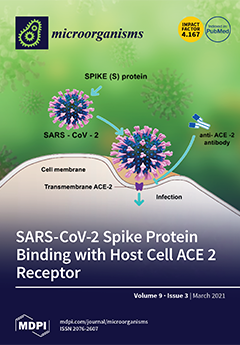Actinotignum schaalii is an emerging, opportunistic pathogen and its connection to non-infectious diseases and conditions, such as prostate or bladder cancer, or chronic inflammation has been proposed. Here, we analyzed 297 urine, ureteral and urinary catheter samples from 128 patients by Polymerase Chain
[...] Read more.
Actinotignum schaalii is an emerging, opportunistic pathogen and its connection to non-infectious diseases and conditions, such as prostate or bladder cancer, or chronic inflammation has been proposed. Here, we analyzed 297 urine, ureteral and urinary catheter samples from 128 patients by Polymerase Chain Reaction followed by Denaturing Gradient Gel Electrophoresis and Sequencing (PCR-DGGE-S), and culture, and 29 of these samples also by
16S rRNA Illumina sequencing, to establish
A. schaalii’s prevalence in urinary tract-related samples, its relation to other bacteria, and its potential association with patients’ conditions and samples’ characteristics.
A. schaalii-positive samples were significantly more diverse than
A.
schaalii negative and between-group diversity was higher than intra-group.
Propionimicrobium lymphophilum, Fusobacterium nucleatum, Veillonella sp.,
Morganella sp., and
Aerococcus sp. were significantly more often present in
A. schaalii-positive samples; thus, we suggest these species are
A. schaalii’s concomitants, while
Enterobacter and Staphylococcaceae were more often identified in
A. schaalii-negative samples; therefore, we propose
A. schaalii and these species are mutually exclusive. Additionally, a significantly higher
A. schaalii prevalence in patients with ureter stricture associated hydronephrosis (
p = 0.020) was noted. We suggest that
A. schaalii could be an early polybacterial biofilm colonizer, together with concomitant species, known for pro-inflammatory features.
Full article






